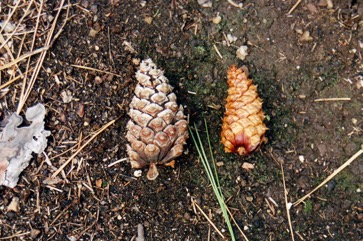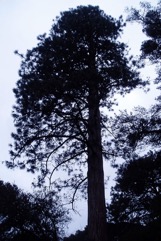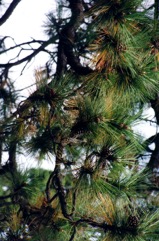Ponderosa Pine

It is a temperate plant. It grows on mountain slopes in North America. It grows in areas subject to frequent forest fires. It will grow on a variety of soils. It cannot tolerate shade. It suits hardiness zones 3-9. ACT Yarralumla. In Hobart Botanical gardens.
Also known as:
Bull Pine, Western Yellow Pine
Edible Portion
- Seeds, Bark
Where does Ponderosa Pine grow?
Found in: Australia, Britain, Canada, Central America, China, Mexico, North America, Tasmania, United States
Notes: There are over 100 species of Pinus.
Growing Ponderosa Pine
Edible Uses: The inner bark is eaten. It is the cambium layer between the wood and the bark. It is eaten fresh or roasted. The seeds are eaten raw. The leaves are used for tea. Caution: The tea should not be drunk in large amounts. It should not be drunk by pregnant women.
Production: Trees can live for several hundred years. They develop seed crops every 2-5 years. The cambium is harvested from young trees or from twigs on older trees. It is best collected on cool, cloudy days when the sap is running. The scales from the cones are collected and dried until the seeds can be shaken out.
Nutrition Info
per 100g edible portion| Edible Part | Energy (kcal) | Protein (g) | Iron (mg) | Vitamin A (ug) | Vitamin c (mg) | Zinc (mg) | % Water |
|---|---|---|---|---|---|---|---|
| - | - | - | - | - | - |
Ponderosa Pine Photos



References
Beckstrom-Sternberg, Stephen M., and James A. Duke. "The Foodplant Database." http://probe.nalusda.gov:8300/cgi-bin/browse/foodplantdb.(ACEDB version 4.0 - data version July 1994)
Bodkin, F., 1991, Encyclopedia Botanica. Cornstalk publishing, p 802
Brickell, C. (Ed.), 1999, The Royal Horticultural Society A-Z Encyclopedia of Garden Plants. Convent Garden Books. p 803.
CASTETTER,
Ciesla, W.M., 1998, Non-wood forest products from conifers. Non-wood forest products 12, FAO, Rome, p 72
Coombes, A.J., 2000, Trees. Dorling Kindersley Handbooks. p 73
Cundall, P., (ed.), 2004, Gardening Australia: flora: the gardener's bible. ABC Books. p 1050
Etkin, N.L. (Ed.), 1994, Eating on the Wild Side, Univ. of Arizona. p 71
Farrar, J.L., 1995, Trees of the Northern United States and Canada. Iowa State University press/Ames p 52
Fu Liguo, Li Nan, Mill, R.R., Pinaceae. Flora of China.
Grandtner, M. M., 2008, World Dictionary of Trees. Wood and Forest Science Department. Laval University, Quebec, Qc Canada. (Internet database http://www.wdt.qc.ca) (Pinus ponderosa)
Harris, E & J., 1983, Field Guide to the Trees and Shrubs of Britain. Reader's Digest. p 252
Hibbert, M., 2002, The Aussie Plant Finder 2002, Florilegium. p 234
Hussey, B.M.J., Keighery, G.J., Cousens, R.D., Dodd, J., Lloyd, S.G., 1997, Western Weeds. A guide to the weeds of Western Australia. Plant Protection Society of Western Australia. p 14
Kermath, B. M., et al, 2014, Food Plants in the Americas: A survey of the domesticated, cultivated and wild plants used for Human food in North, Central and South America and the Caribbean. On line draft. p 662 (As Pinus ponderosa)
Lord, E.E., & Willis, J.H., 1999, Shrubs and Trees for Australian gardens. Lothian. p 87
MacKinnon, A., et al, 2009, Edible & Medicinal Plants of Canada. Lone Pine. p 33
Menninger, E.A., 1977, Edible Nuts of the World. Horticultural Books. Florida p 156
MINNIS,
Moerman, D. F., 2010, Native American Ethnobotany. Timber Press. p 412
Plants for a Future database, The Field, Penpol, Lostwithiel, Cornwall, PL22 0NG, UK. http://www.scs.leeds.ac.uk/pfaf/
Turner, N. J., 1988, Ethnobotany of Coniferous Tress in Thompson and Lillooet Interior Salish of British Colombia. Economic Botany 42(2) :177-194
S. Watson, Bot. California 2:126. 1880
Turner, N., 1997, Food Plants of Interior First Peoples. Royal BC Museum Handbook p 55
Wickens, G.E., 1995, Edible Nuts. FAO Non-wood forest products. FAO, Rome. p176